
The conservation status of a group of organisms indicates whether the group still exists and how likely the group is to become extinct in the near future. Many factors are taken into account when assessing conservation status: not simply the number of individuals remaining, but the overall increase or decrease in the population over time, breeding success rates, and known threats. Various systems of conservation status exist and are in use at international, multi-country, national and local levels as well as for consumer use.
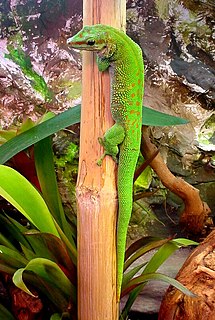
Phelsuma madagascariensis is a species of day gecko that lives in Madagascar. It is among the most widespread day geckos and is found in a wide range of habitats. With a length of up to 30.5 centimetres (12.0 in), it is also the largest day gecko in Madagascar.
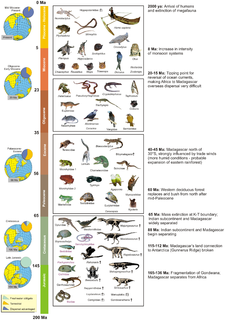
The fauna of Madagascar is a part of the wildlife of Madagascar.
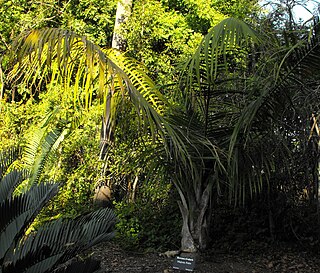
Ravenea is a genus of 20 known species of palms, all native to Madagascar and the Comoros.

Lemerle's dwarf hippopotamus is an extinct species of Malagasy hippopotamus.

A species that is extinct in the wild (EW) is one that has been categorized by the International Union for Conservation of Nature as known only by living members kept in captivity or as a naturalized population outside its historic range due to massive habitat loss.

The white-throated oxylabes is a species of passerine bird. Formerly considered part of the Old World warbler family Sylviidae, it has been moved to the family Bernieridae — the Malagasy warblers. It is endemic to Madagascar, where its natural habitat is subtropical or tropical moist lowland forests.
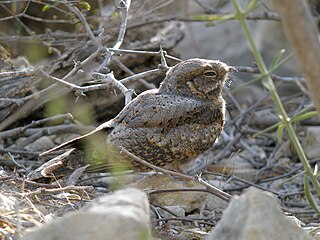
The Madagascar nightjar is a species of nightjar in the family Caprimulgidae. It is native to Madagascar, Nosy Boraha and Aldabra. Its natural habitats are subtropical or tropical moist lowland forest and subtropical or tropical moist montane forest.
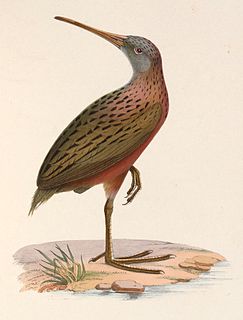
The Madagascar rail is a species of bird in the family Rallidae.

The banded lampeye is a species of poeciliid that is native to Africa, ranging from Senegal to Angola. It is mainly found in coastal brackish habitats such as river mouths, lagoons and mangrove swamps. It reaches up to 7 cm (2.8 in) in total length.
The Madagascar sea catfish is a species of fish in the family Ariidae. It is found in Madagascar, Mozambique, and Tanzania. Its natural habitats are rivers, freshwater lakes, shallow seas, and estuarine waters. The Madagascar Sea Catfish has a common length of 20 centimeters, but may reach 70 centimeters.

The red-tailed silverside, or zona is a species of Madagascar rainbowfish endemic to the Mananjary River drainage in Madagascar. It is threatened by habitat loss and introduced species. It has often been confused with the related B. madagascariensis, which is common in the aquarium trade. In addition to meristics, the two can be separated by the exact colour pattern on their tail fin and the distinct red spot on the lower jaw of breeding male B. geayi. B. geayi was described in 1907 by Jacques Pellegrin from a type collected by the pharmacist and natural history collector Martin François Geay (1859-1910), who Pellegrin honoured with its specific name.
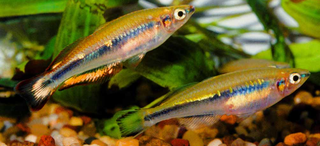
Bedotia madagascariensis (zona) is a species of fish in the family Bedotiidae. It is endemic to Madagascar, where found in rivers and lakes between the Ivoloina River and the Manambolo Creek. It is commonly seen in the aquarium trade, where it often has been confused with the related B. geayi. It is threatened by habitat loss. It was described by Charles Tate Regan in 1903 with Madagascar given as the type locality, Regan deposited the type in the Muséum d'histoire naturelle de Genève and named the genus in honour of its director Maurice Bedot (1859-1927).
Pantanodon sp. nov. 'Manombo' is a species of fish in the family Poeciliidae. It is endemic to Madagascar. Its natural habitats are rivers and swamps. It is critically endangered and threatened by habitat loss.
The eastcoast lampeye is a species of fish in the family Poeciliidae. It is endemic to coastal Kenya and Tanzania, where found in brackish water, mangrove swamps, pools, lagoons and river deltas. It reaches up to 5 cm (2.0 in) in total length. This fish was described by Ernst Ahl as Haplochilichthys stuhlmanni with the type locality given as Tanganyika Territory. The specific name honours the co-leader of the German East Africa Expedition (1889-1892) on which type was collected, Franz Ludwig Stuhlmann (1863-1928) of the German Colonial Service.

Typhleotris madagascariensis is a species of fish in the family Milyeringidae that is endemic to Madagascar, where it is only known from underground waters in the southwestern portion of the island. This cavefish is blind and lacks pigmentation, and can reach a standard length of 8 cm (3.1 in).

Cavefish or cave fish is a generic term for fresh and brackish water fish adapted to life in caves and other underground habitats. Related terms are subterranean fish, troglomorphic fish, troglobitic fish, stygobitic fish, phreatic fish and hypogean fish.
Typhleotris mararybe is a critically endangered species of fish in the family Milyeringidae, the blind cave gobies. It is a troglobitic species endemic to cave habitat in southwestern Madagascar. It is unique among known cave-dwelling fish in that is both blind and darkly pigmented. It has well-developed nonvisual sensory systems and dives to avoid approaching objects. The fish was first collected in 2008 and was described to science as a new species in 2012.
This page is based on this
Wikipedia article Text is available under the
CC BY-SA 4.0 license; additional terms may apply.
Images, videos and audio are available under their respective licenses.













